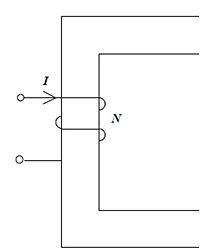Magnetic Circuits: Difference between revisions
Andrew.Sell (talk | contribs) No edit summary |
Andrew.Sell (talk | contribs) No edit summary |
||
| Line 2: | Line 2: | ||
==Magnetomotive Force== |
==Magnetomotive Force== |
||
Magnetic force, in general, can be thought of as the work that would be done to carry a unit magnetic pole around the entire magnetic circuit.<ref>[http://books.google.com/books?id=noBCAAAAIAAJ&pg=PA265&dq#v=onepage&q=&f=false Magnetic induction in iron and other metals] Sir James Alfred Ewing</ref>Permanent magnets display this behavior naturally and it is constant as long as the magnet is not tampered with. In contrast, the magnetic force in electromagnets is primarily influenced by both the amount of current and the number of turns around a given core.<ref>[http://books.google.com/books?id=HS4tIPQ1OBoC&pg=PA108&dq=#v=onepage&q=&f=false The beginner's handbook of amateur radio] Sir James Alfred Ewing]</ref> |
Magnetic force, in general, can be thought of as the work that would be done to carry a unit magnetic pole around the entire magnetic circuit.<ref>[http://books.google.com/books?id=noBCAAAAIAAJ&pg=PA265&dq#v=onepage&q=&f=false Magnetic induction in iron and other metals] Sir James Alfred Ewing</ref>Permanent magnets display this behavior naturally and it is constant as long as the magnet is not tampered with. In contrast, the magnetic force in electromagnets is primarily influenced by both the amount of current and the number of turns around a given core.<ref>[http://books.google.com/books?id=HS4tIPQ1OBoC&pg=PA108&dq=#v=onepage&q=&f=false The beginner's handbook of amateur radio] Sir James Alfred Ewing]</ref> |
||
[[Image:Ampere-turns.JPG|thumb|200px|right ]] |
[[Image:Ampere-turns.JPG|thumb|200px|right ]] |
||
| Line 10: | Line 10: | ||
and has units of ampere-turn (At). |
and has units of ampere-turn (At). |
||
| Line 19: | Line 22: | ||
===Permeability=== |
===Permeability=== |
||
Magnetic permeability is a measure of a materials ability to propagate magnetic flux. A higher permeability leads to a stronger magnet. The idea of permeability is similar to that of conduction. Since materials with a high conductivity allow electric current to flow easily, likewise, materials whose permeability is high, allow magnetic flux to move easier.<ref>[http://info.ee.surrey.ac.uk/Workshop/advice/coils/mu/#mu Magnetic properties of materials workshop]</ref> |
|||
The permeability of a certain material is not |
The permeability of a certain material is not necessarily either constant nor linear, since, by definition a materials permeability |
||
Permeability of a material can be measured relative to the permeability of a vacuum (also known as the permeability of free space) whose constant is <math>\mu_0 = 4 \pi \times 10^{-7}</math> giving a relative permeability found by:<ref>[http://www.lightandmatter.com/html_books/0sn/ch11/ch11.html Simple Nature] Benjamin Crowell</ref> |
Permeability of a material can be measured relative to the permeability of a vacuum (also known as the permeability of free space) whose constant is <math>\mu_0 = 4 \pi \times 10^{-7}</math> giving a relative permeability found by:<ref>[http://www.lightandmatter.com/html_books/0sn/ch11/ch11.html Simple Nature] Benjamin Crowell</ref> |
||
Revision as of 20:15, 7 January 2010
A magnetic circuit can be described as a complete closed path of any group of lines of magnetic flux. Magnetic flux is generated by permanent magnets, electromagnets or other types of magnetic materials and is described as a measure of the number of magnetic field lines that pass perpendicularly through a surface. There are a number good analogies between magnetic and electric circuits, for instance; magnetic flux is related to electrical current, reluctance is related to resistance and finally, what is known as magnetomotive force corresponds to electromotive force<ref> Dictionary.com </ref>. The use of magnetic circuits is very broad and extends to many electrical/mechanical devices such as motors and generators.
Magnetomotive Force
Magnetic force, in general, can be thought of as the work that would be done to carry a unit magnetic pole around the entire magnetic circuit.<ref>Magnetic induction in iron and other metals Sir James Alfred Ewing</ref>Permanent magnets display this behavior naturally and it is constant as long as the magnet is not tampered with. In contrast, the magnetic force in electromagnets is primarily influenced by both the amount of current and the number of turns around a given core.<ref>The beginner's handbook of amateur radio Sir James Alfred Ewing]</ref>
By definition, the Magnetomotive force is found by multiplying the current I by the number of turns N in a coil, thus magnetomotive force is:
and has units of ampere-turn (At).
Permeability
Magnetic permeability is a measure of a materials ability to propagate magnetic flux. A higher permeability leads to a stronger magnet. The idea of permeability is similar to that of conduction. Since materials with a high conductivity allow electric current to flow easily, likewise, materials whose permeability is high, allow magnetic flux to move easier.<ref>Magnetic properties of materials workshop</ref>
The permeability of a certain material is not necessarily either constant nor linear, since, by definition a materials permeability
Permeability of a material can be measured relative to the permeability of a vacuum (also known as the permeability of free space) whose constant is giving a relative permeability found by:<ref>Simple Nature Benjamin Crowell</ref>
Reluctance
As was stated earlier, electrical resistance is the same as magnetic reluctance (Section under construction)
References
<references/>




